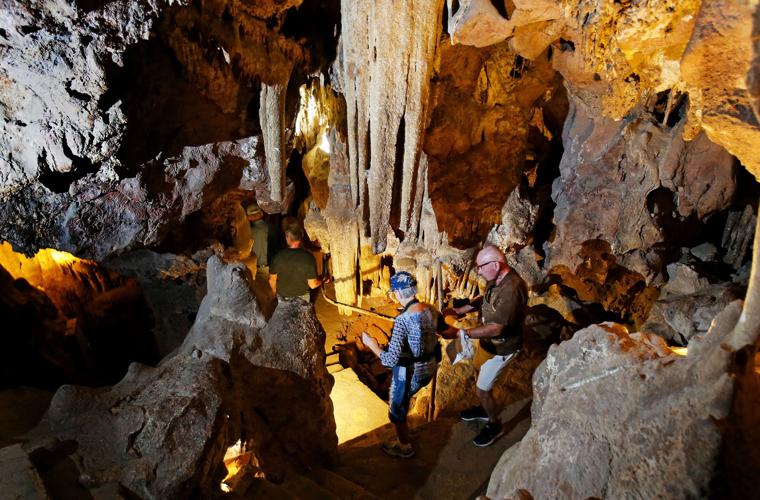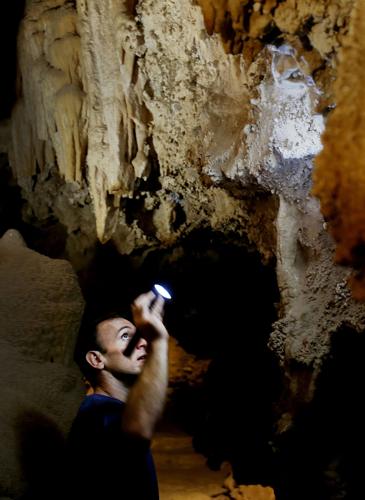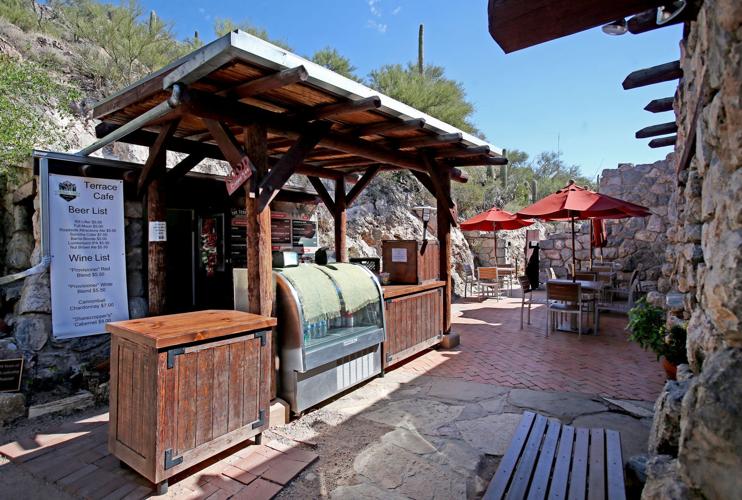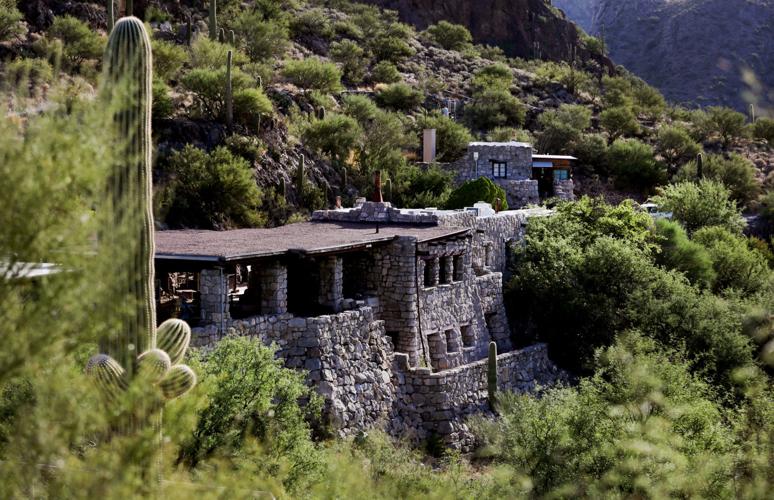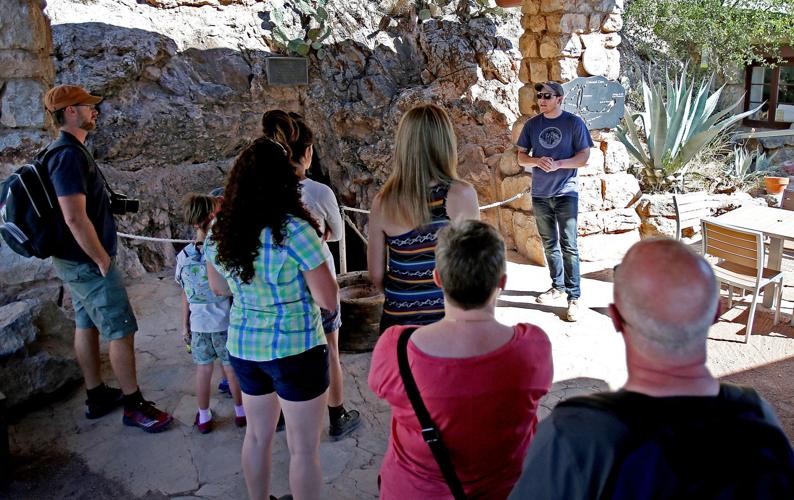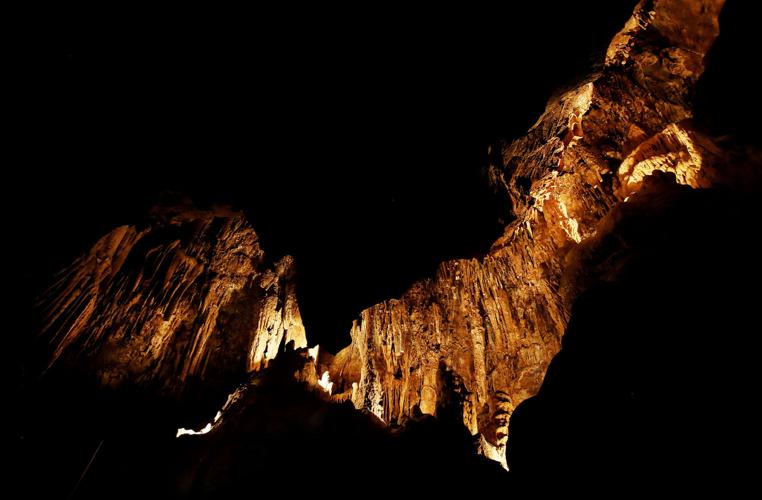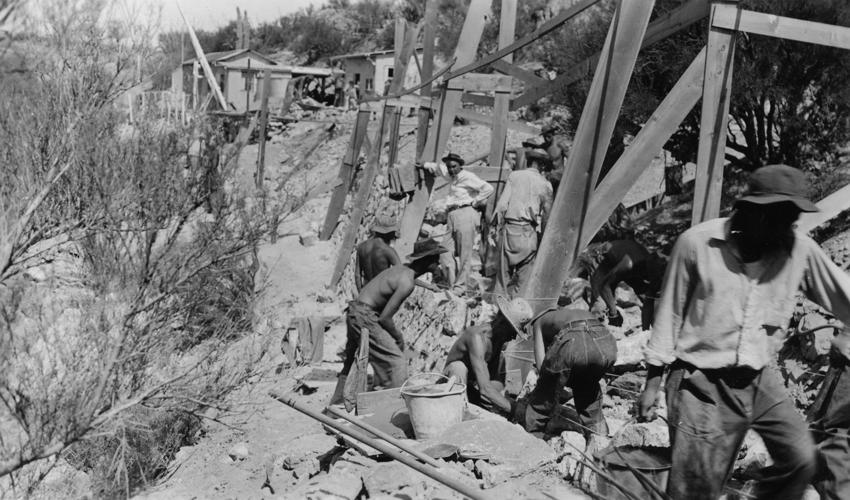It’s 100 degrees and the Arizona sun is beating down, sweat dripping down the faces of visitors. With camera in one hand and a water bottle in the other, guests walk up the stairs leading to Colossal Cave Mountain Park.
The park is surrounded by saguaro and prickly pear cacti, and cautionary signs warning pedestrians about possible critters passing by. Children giggle as they dig through the park’s new mineral sluice, constantly questioning when the cave tour will begin. Adults lean against the walls made of stone, attempting to hide from the heat of the sun.
As time passes, visitors line up behind a thin rope. Beyond the rope is a metal gate labeled “Colossal Cave.” Kids lean over the rope, anxious to enter.
The current tour guide, Savannah, emerges and introduces herself. She provides a rundown of the rules: Don’t touch anything, make sure all tennis shoes are tied, hold on to hats and sunglasses, no gum.
The half-mile cave tour begins. One girl, maybe 8 or 9, sports a neon pink hard hat as she sprints to the cave’s entrance. “I see gold down there!” another girl exclaims, pointing at the lights glistening through the entryway.
In a matter of minutes, the group of visitors become encompassed by the cave’s darkness, which is lowly lit by “stalac-lights” as Savannah calls them. The temperature drops to a crisp 70 degrees. Despite the lack of water in the cave, it has a 60 percent humidity and smells musty in certain areas — as if you left a wet towel in your laundry hamper for way too long.
When Savannah isn’t talking, the only sounds in the cave are the group’s footsteps and the whimpers of a child scared of the dark. Everyone else stands back in awe, engaging in the surrounding nature.
For hundreds of years, Colossal Cave has been dormant, which means it no longer grows any formations. The park also has two live caves onsite, Arkenstone and La Tetera, which are closed to tourists. Pima County also closed the caves to scientists and researchers.
Colossal Cave has an interesting history, including the stories of 1884 bandits who stole $72,000 in gold and hid it in the cave. The bandits died in a shootout and the money was never found. “If you find it, you have to split it with your tour guide,” Savannah joked.
Josh Rose, from San Diego, was visiting his in-laws for the Labor Day weekend. His family decided to visit Colossal Cave.
“It’s our first time here,” he said. “We were just looking for something to do and found the cave. I’m excited to see the different bats and stalactites.”
The park bustled with people on the Sunday before Labor Day. The cave tours sold out before 7 a.m. Besides Rose and his family, many others were visiting the cave for their first time, some also from out of town.
Lendel Martin, who makes pizzas and burgers at Colossal Cave’s Terrace Cafe, said on Black Friday alone he heard that the cave welcomed over 650 visitors. He also mentioned that until November 2015, the Terrace Cafe was home to an old, dingy storage space. “The new company remodeled everything and turned the storage area into a kitchen,” he said.
Escabrosa Inc. managed the Pima County-owned park for more than 50 years. But in 2014, the Pima County Board of Supervisors voted against renewing the company’s contract after an audit found too few people were visiting. The county awarded the contract to Ortega National Parks in 2015, which manages concessions in parks across the country.
Diane Frisch, Pima County’s attractions and tourism director, said the park has had many upgrades and renovations since the switch. Both revenue and attendance have risen in the past two years, she said.
“We are very pleased with them,” Frisch said about Ortega. “They’ve done a good job of managing the park and being respectful toward the historical and archaeological portions of the park.” She also said that Ortega has done a good job with advertising.
The Ortega company increased the price of cave tours to $16 from $13, but eliminated the original $5 admission fee for passers-by who want to hike or ride horses through the park. Ortega also added the children’s sluice machine, public restrooms near the cave, and new asphalt in the parking area. The company also expanded the gift shop.
Susan Goldstein-Wallace went to Colossal Cave as a kid. Now grown up with a family of her own, she has taken her son to the park twice — once four years ago, and once this past summer.
“When we went recently, I noticed a lot of upgrades,” she said. “My son played with the new sluice. The gift shop was well-stocked and had a lot of variety, and the bathrooms were very accessible. They serve food now, too. It was nice to have the option to eat lunch and have a cool drink.”
She said her previous trips were also nice, but she enjoyed the park’s improvements.
Bobby King, who has worked at the cave’s gift shop for a year and a half, said he has witnessed improvements “on all fronts” under the new management company. He also said that Ortega has proposed to create a zip line and a bed and breakfast at the park.
“The bed and breakfast will happen further down the line due to the historical nature of building around the park,” King said. “But we already have a lot of people who want to be on a reservation list for it.” He said many people also inquire about the zip line.
When cruising down Old Spanish Trail to get to the park, visitors come to a fork in the road, literally. Merging left leads to the cave; merging right leads to the ranch, which offers a museum, petting zoo, butterfly garden, tortoise exhibit, horseback riding, and camping and picnic facilities.
Rose and his family were unaware that Colossal Cave had more attractions.
“From a marketing standpoint, I think it would be beneficial to have a trail or something to connect the two areas,” Rose said. “And a zip line would definitely bring me back.”
Genie Nielsen shared a similar experience as Rose. As a first-time Colossal Cave visitor, she was excited to tour the cave.
“We wanted to visit Saguaro National Park, but they’re doing a race there this morning,” Nielsen said. “We saw the signs advertising Colossal Cave on our way up, so we decided to try that instead.”
Nielsen wasn’t aware of the other attractions that Colossal Cave offers, but said that the current exhibits, in addition to the zip line and bed and breakfast, sounded interesting.
The county’s Frisch said that although a hiking trail or something connecting the two areas isn’t in the immediate works, they are always looking for ways to improve the facility. She confirmed that a zip line and bed and breakfast were in the talks, stating that they are “things that the county is looking at.”
“First and foremost, we always want to be good stewards of the property,” she said. “We want to make sure we’re taking care of the park.
Goldstein-Wallace said she didn’t know about the park’s other activities until her most recent visit.
“I remember as a kid when my grandparents would take me to the cave, the park was in the middle of nowhere,” she said. “Now Tucson has expanded, and people still don’t know it’s out there. I think if people knew about it, they would go out there and make a whole day out of it.
Back inside the cave, we come to Crystal Forest, which is covered with stalactites — brown icicle-shaped formations dangling from the top of the cave. Savannah said that if the cave were wet, the icicles would be sparkling.
We also meet Old Baldy, who is the one exception to the “no touch” rule.
“It’s believed if you touch him, you won’t bump your heads,” Savannah joked.
We come across the “Cave Witch,” a rock formation that looks like the side profile of a wicked witch with a long nose and “snaggly tooth” as Savannah calls it. Along the way, we pass by cave bacon and popcorn — which apparently just taste like rock, Savannah said.
A display case houses an ancient metate and mano used to grind food. Next to the tools sits a plastic corn on the cob. “That corn is probably bad by now,” a little girl declared
By the end of the tour, some children grow antsy and tired. Others want to see more. But 363 steps later, visitors are out of the cave and back in the bright sun.


